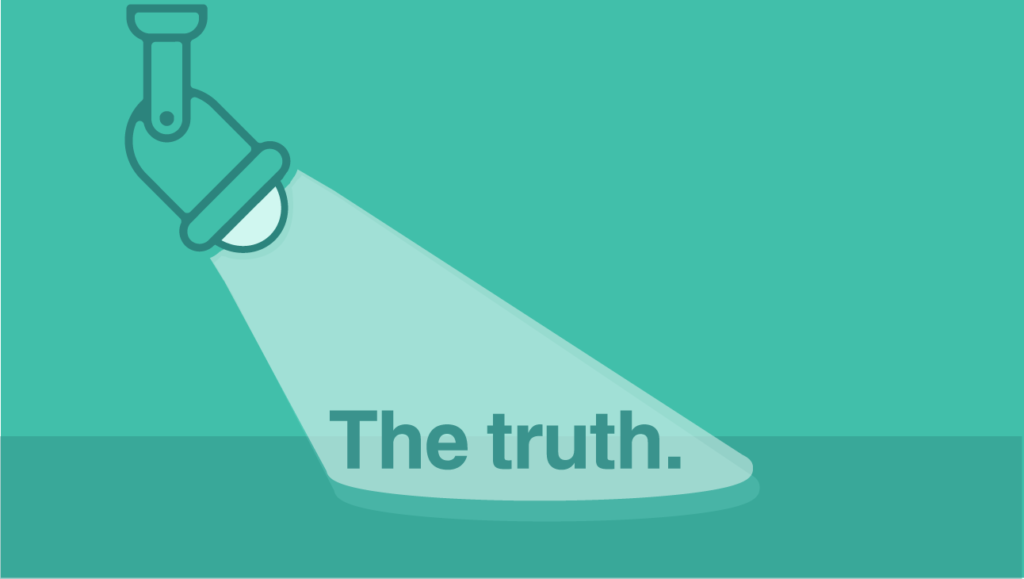The world is moving faster than ever, and when you combine that with the resulting volatility, ambiguity and complexity, most organizations are left in constant survival mode. Trying to act and react while simultaneously attempting to plan for the (uncertain) future is, frankly, exhausting. And the bad news is that the world doesn’t seem to be slowing down or getting simpler any time soon.
There is a path to clarity, though. We’ve found that the most successful and effective organizations have one thing in common: They root their business and brand strategies in Truth (with a capital T). This kind of Truth is one that breaks through personal preferences, competitive noise and other distractions to create a clear, ownable position from which business decisions can be made confidently and quickly.
The trouble is, the Truth is hard to come by.
It requires digging in, exercising empathy, creativity and, most importantly, self-reflection, to uncover the insights that will move your organization forward. It’s not easy and often requires expert guidance, which is why we’ve built an entire discipline around this type of strategic consultation.
How we find the Truth.
Nearly every engagement begins with some basic requests and requirements that are driving the interaction. Our conversations with potential client partners usually start like this:
Client: “We need to do a branding project. We feel like the brand we have today doesn’t tell our story.”
E&S: “Great! Brands are important. Knowing you want to tell your story … do you think there’s a lot of clarity in the organization about what that story is?”
Client: “Well, yes. We all definitely know it. It’s just not written down anywhere.”
E&S: “So everyone has a slightly different version in their heads, probably?”
Client: “Yeah. That seems right. We just need to get our story out of our heads and on paper so we can all agree on it.”
And there it is. The first glimmer that maybe there’s not 100% alignment around the organizational direction. Which is totally OK. This is where we come in.
Alignment and truth go hand in hand. And, generally, the only way to get to that big, universal Truth that can drive your organization forward (or is currently holding you back) is to dig in together. That introspection takes time, but we keep in mind several core principles when crafting each engagement:
- Start with a diverse group of people.
When we’re trying to understand complex organizational dynamics, it is important to get input from a variety of perspectives. This means engaging with executives and frontline workers, as well as customers, clients and partners. - Be open to hearing different perspectives.
If we are going to get a diverse group of folks together, we need to create an environment where conflicting perspectives can be safely shared and heard. The idea is to develop generative conflict that helps everyone, including us, be more aware of the blind spots that come with our previously held assumptions. This will help you to understand the problem from all sides and to develop a more comprehensive solution. - Consider all the available data.
We don’t just rely on the data that is convenient or that supports our existing beliefs. We look at all the relevant points, even if they are challenging or contradictory. Some of the most innovative solutions come from the most unpleasant data discoveries. - Create a shared understanding of the landscape.
Through research and discovery, we’re able to take a third-party, unbiased view of what’s happening both inside the organization and out. We then work to educate our partners, with facts, to help create a more holistic view of the issue. - Be willing to ask difficult questions.
Once everyone has had an opportunity to see the bigger picture, the problem-solving can begin. We’re not afraid to ask the tough questions that no one else is asking. This is the only way to get to the bottom of complex issues. - Be willing to receive difficult answers.
Sometimes we ask really hard questions. And sometimes we have to hear really tough answers. But the reality is that, more often than not, the toughest of these answers is the Truth. The big, capital-T truth we’ve been looking for. And that is a great moment.
Where to go from the Truth.
Once we’ve discovered the underlying Truth beneath your issues, we’re able to start building upon it. And we know it’s the Truth when brand strategies and marketing approaches come naturally and clearly in the process. These strategies are quickly embraced by internal audiences … because they ring true. The organization and the clarified brand also resonate easily with external audiences, such as customers and prospects.
Ultimately, once your Truth is discovered, it yields quick alignment and easier decision-making. With the certain footing that Truth delivers, leaders can better navigate the volatilities and complexities of today … and tomorrow.
